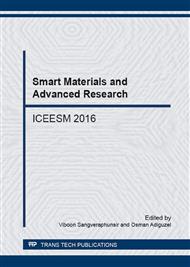[1]
T. Kamal, S. -Y. Park, J. -H. Park, Y. -W. Chang, Structural evolution of poly(ether-b-amide12) elastomers during the uniaxial stretching: An in situ wide-angle X-ray scattering study, Macromol. Res., 20 (2012) 725-731.
DOI: 10.1007/s13233-012-0109-z
Google Scholar
[2]
J.P. Sheth, J. Xu, G.L. Wilkes, Solid state structure–property behavior of semicrystalline poly(ether-block-amide) PEBAX® thermoplastic elastomers, Polymer, 44 (2003) 743-756.
DOI: 10.1016/s0032-3861(02)00798-x
Google Scholar
[3]
P. Bernardo, J.C. Jansen, F. Bazzarelli, F. Tasselli, A. Fuoco, K. Friess, P. Izák, V. Jarmarová, M. Kačírková, G. Clarizia, Gas transport properties of Pebax®/room temperature ionic liquid gel membranes, Separation and Purification Technology, 97 (2012).
DOI: 10.1016/j.seppur.2012.02.041
Google Scholar
[4]
V. Bondar, B. Freeman, I. Pinnau, Gas sorption and characterization of poly (ether‐b‐amide) segmented block copolymers, Journal of Polymer Science Part B: Polymer Physics, 37 (1999) 2463-2475.
DOI: 10.1002/(sici)1099-0488(19990901)37:17<2463::aid-polb18>3.0.co;2-h
Google Scholar
[5]
S. Armstrong, B. Freeman, A. Hiltner, E. Baer, Gas permeability of melt-processed poly(ether block amide) copolymers and the effects of orientation, Polymer, 53 (2012) 1383-1392.
DOI: 10.1016/j.polymer.2012.01.037
Google Scholar
[6]
A.M. Ádámné, K. Belina, M. Pósa, B. Kecskés, Investigation of mechanical and thermal properties of oriented polyamid copolymer, Int J Mater Form, 1 (2008) 587-590.
DOI: 10.1007/s12289-008-0324-5
Google Scholar
[7]
K.A.A. Halim, J.E. Kennedy, J.B. Farrell, Preparation and characterisation of polyether-block-amide/montmorillonite (MMT) nanocomposites for use in angioplasty balloon applications, 1st International Malaysia Ireland Joint Symposium, (2011).
DOI: 10.1016/j.matchemphys.2013.09.007
Google Scholar
[8]
H. Meng, G. Li, A review of stimuli-responsive shape memory polymer composites, Polymer, 54 (2013) 2199-2221.
DOI: 10.1016/j.polymer.2013.02.023
Google Scholar
[9]
Y.C. Jung, H.J. Yoo, Y.A. Kim, J.W. Cho, M. Endo, Electroactive shape memory performance of polyurethane composite having homogeneously dispersed and covalently crosslinked carbon nanotubes, Carbon, 48 (2010) 1598-1603.
DOI: 10.1016/j.carbon.2009.12.058
Google Scholar
[10]
Y.C. Jung, J.H. Kim, T. Hayashi, Y.A. Kim, M. Endo, M. Terrones, M.S. Dresselhaus, Fabrication of Transparent, Tough, and Conductive Shape‐Memory Polyurethane Films by Incorporating a Small Amount of High‐Quality Graphene, Macromolecular rapid communications, 33 (2012).
DOI: 10.1002/marc.201100674
Google Scholar
[11]
G. Xing, H. Guo, X. Zhang, T.C. Sum, C.H.A. Huan, The physics of ultrafast saturable absorption in graphene, Optics express, 18 (2010) 4564-4573.
DOI: 10.1364/oe.18.004564
Google Scholar
[12]
D.R. Dreyer, R.S. Ruoff, C.W. Bielawski, From conception to realization: an historial account of graphene and some perspectives for its future, Angewandte Chemie International Edition, 49 (2010) 9336-9344.
DOI: 10.1002/anie.201003024
Google Scholar
[13]
S. Kazarian, Polymer processing with supercritical fluids, POLYMER SCIENCE SERIES CC/C OF VYSOKOMOLEKULIARNYE SOEDINENIIA, 42 (2000) 78-101.
Google Scholar
[14]
F. Cansell, C. Aymonier, A. Loppinet-Serani, Review on materials science and supercritical fluids, Current Opinion in Solid State and Materials Science, 7 (2003) 331-340.
DOI: 10.1016/j.cossms.2004.01.003
Google Scholar
[15]
J.R. Combes, S. Kumar, L.S. Smith, H.K. Mahabadi, P.G. Odell, Supercritical fluid processes, Google Patents, (2000).
Google Scholar
[16]
A.I. Cooper, Polymer synthesis and processing using supercritical carbon dioxide, Journal of Materials Chemistry, 10 (2000) 207-234.
Google Scholar
[17]
V. Goodship, E. Ogur, Polymer Processing with Supercritical Fluids, Smithers Rapra, Shrewsbury, GBR, (2004).
Google Scholar
[18]
S.R. Marre, Y.; Aymonier, C, Supercritical microfluidics: Opportunities in flow-through chemistry and materials science, . J. Supercrit. Fluids, (2011).
DOI: 10.1016/j.supflu.2011.11.029
Google Scholar
[19]
S.P. Nalawade, F. Picchioni, L.P.B.M. Janssen, Supercritical carbon dioxide as a green solvent for processing polymer melts: Processing aspects and applications, Progress in Polymer Science, 31 (2006) 19-43.
DOI: 10.1016/j.progpolymsci.2005.08.002
Google Scholar
[20]
O.S. Fleming, S.G. Kazarian, Polymer Processing with Supercritical Fluids, Supercritical Carbon Dioxide, Wiley-VCH Verlag GmbH & Co. KGaA2006, pp.205-238.
DOI: 10.1002/3527606726.ch10
Google Scholar
[21]
G.K. Serhatkulu, C. Dilek, E. Gulari, Supercritical CO2 intercalation of layered silicates, J. Supercrit. Fluids, 39 (2006) 264-270.
DOI: 10.1016/j.supflu.2006.07.028
Google Scholar
[22]
J.W. Tom, P.G. Debenedetti, Particle formation with supercritical fluids—a review, Journal of Aerosol Science, 22 (1991) 555-584.
DOI: 10.1016/0021-8502(91)90013-8
Google Scholar
[23]
M. Sauceau, J. Fages, A. Common, C. Nikitine, E. Rodier, New challenges in polymer foaming: a review of extrusion processes assisted by supercritical carbon dioxide, Progress in Polymer Science, 36 (2011) 749-766.
DOI: 10.1016/j.progpolymsci.2010.12.004
Google Scholar
[24]
J.G. Lyons, M. Hallinan, J.E. Kennedy, D.M. Devine, L.M. Geever, P. Blackie, C.L. Higginbotham, Preparation of monolithic matrices for oral drug delivery using a supercritical fluid assisted hot melt extrusion process, International Journal of Pharmaceutics, 329 (2007).
DOI: 10.1016/j.ijpharm.2006.08.028
Google Scholar
[25]
J.H. Kim, S.Y. Ha, Y.M. Lee, Gas permeation of poly(amide-6-b-ethylene oxide) copolymer, Journal of Membrane Science, 190 (2001) 179-193.
DOI: 10.1016/s0376-7388(01)00444-6
Google Scholar
[26]
E.J. Beckman, Supercritical and near-critical CO 2 in green chemical synthesis and processing, J. Supercrit. Fluids, 28 (2004) 121-191.
DOI: 10.1016/s0896-8446(03)00029-9
Google Scholar
[27]
S.G. Kazarian, M.F. Vincent, F.V. Bright, C.L. Liotta, C.A. Eckert, Specific Intermolecular Interaction of Carbon Dioxide with Polymers, Journal of the American Chemical Society, 118 (1996) 1729-1736.
DOI: 10.1021/ja950416q
Google Scholar
[28]
J. Vlachopoulos, D. Strutt, Polymer processing, Materials science and technology, 19 (2003) 1161-1169.
DOI: 10.1179/026708303225004738
Google Scholar
[29]
A. Poudel, A. Coffey, J. Kennedy, S. Lyons, K. Thomas, P. Walsh, Dielectric Polarization Enhancement of Thermoplastic Elastomers for Sensing and Energy Harvesting Applications, International Journal of Materials, Mechanics and Manufacturing 4(2016).
DOI: 10.18178/ijmmm.2016.4.4.263
Google Scholar
[30]
K. Shimizu, T. Yasuda, H. Saito, Perpendicular Orientation of Cylindrical Microdomains in Extruded Triblock Copolymer, Macromolecules, 43 (2010) 2088-(2091).
DOI: 10.1021/ma9016373
Google Scholar
[31]
S. Ghose, K.A. Watson, D.C. Working, J.W. Connell, J. Smith, Y. Sun, Thermal conductivity of ethylene vinyl acetate copolymer/nanofiller blends, Composites Science and Technology, 68 (2008) 1843-1853.
DOI: 10.1016/j.compscitech.2008.01.016
Google Scholar
[32]
D.V. Rosato, M.G. Rosato, Injection molding handbook, Springer Science & Business Media2012.
Google Scholar
[33]
T. McNally, P. Pötschke, Polymer-carbon nanotube composites: Preparation, properties and applications, Elsevier2011.
Google Scholar
[34]
A. Tena, S. Shishatskiy, V. Filiz, Poly(ether-amide) vs. poly(ether-imide) copolymers for post-combustion membrane separation processes, RSC Advances, 5 (2015) 22310-22318.
DOI: 10.1039/c5ra01328c
Google Scholar
[35]
M. Colonna, M. Nicotra, M. Moncalero, Materials, designs and standards used in ski-boots for alpine skiing, Sports, 1 (2013) 78-113.
DOI: 10.3390/sports1040078
Google Scholar


